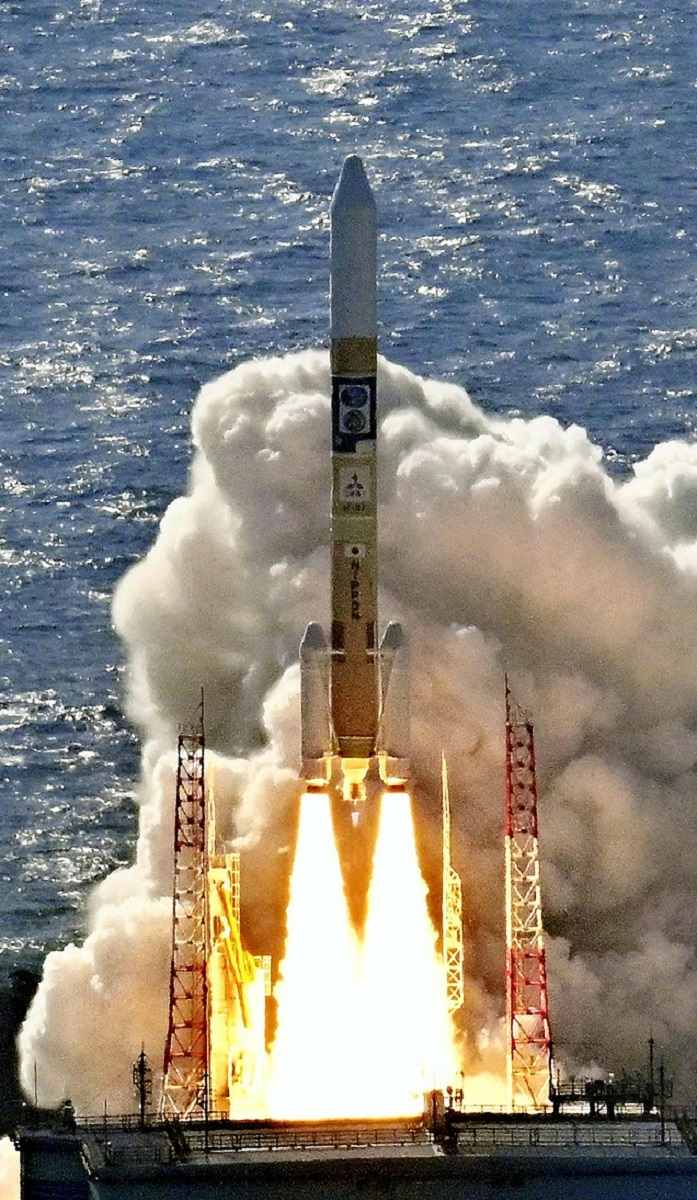
Japan’s H2A rocket carrying a lunar probe lifts off from the Tanegashima Space Center in Kagoshima Prefecture in September 2023.
6:00 JST, May 6, 2024
The Japan Aerospace Exploration Agency (JAXA) plans to develop a demonstration plant for technology that produces fuel for spacecraft on the moon, according to sources.
JAXA intends to independently establish technology that produces fuel from lunar water and will start building a fuel plant on the lunar surface as early as 2035. It aims to run the plant by 2040.
The agency is looking to invite businesses to cooperate in the plant’s development.
To realize long-term lunar surface exploration, it is necessary to send astronauts to the moon and create a sustainable working environment.
Transporting fuel from Earth for spacecraft and rovers on the moon is costly and time-consuming, so it is essential that a plant can manufacture fuel on the moon.
The moon’s poles are believed to contain water ice. JAXA aims to collect water-containing lunar soil from the moon, known as lunar regolith. They will electrolyze the water drawn from the lunar regolith to extract hydrogen for fuel and oxygen as an oxidizer for combustion.
Lunar regolith is made of fine particles created by the impact of meteors — the source of shooting stars — on the moon’s surface. While tests are needed to prevent the lunar dust from entering space suits, research is being done to use regolith as a building material.
By taking advantage of the moon’s low-temperature environment, hydrogen will be stored in liquid form. Liquid hydrogen has been used as fuel for existing rockets, too.
According to estimates, 57.6 tons of fuel a year is necessary for continuous activity on the moon.
Under the contract with companies including Yokohama-based JGC Corp., an affiliate of major plant operator JGC Holdings Corp., JAXA has been developing a conceptual design for a demonstration plant.
JAXA intends to publicly solicit companies in and after this fiscal year that can cooperate in constructing an experimental facility in Japan that simulates the lunar environment. The agency plans to conduct a geotechnical survey on the lunar surface in the 2030s after a technology demonstration by the private sector, government and academia. JAXA aims to start constructing the fuel plant in or after 2035.
In April, the Japanese and U.S. governments agreed to send two Japanese astronauts to the moon’s surface in the U.S.-led Artemis lunar exploration program. The program also envisages the construction of a manned base on the moon.
Other countries have also envisioned fuel plants on the lunar surface that could be built jointly with Japan.
“We need to identify technologies that should be developed with the help of the private sector,” said Jun Shimada, a research and development engineer at JAXA Space Exploration Center. JGC Corp.’s Kiho Fukaura said, “We want to use our experience in plant construction in the project.”
Several companies are expected to participate in lunar surface development.
Takasago Thermal Engineering Co., a Tokyo-based major air conditioning installation company, has developed a water electrolysis system. The Tokyo-based space startup ispace, Inc. will send the system via a lunar lander to be sent to the moon this winter for a demonstration test of water electrolysis. Collecting water vapor on the moon by using a rover to insert a heater into the lunar ground is also under consideration.
Mitsubishi Heavy Industries Ltd. is developing a rover for the Lunar Polar Exploration project, a program between JAXA and the Indian Space Research Organisation.




















